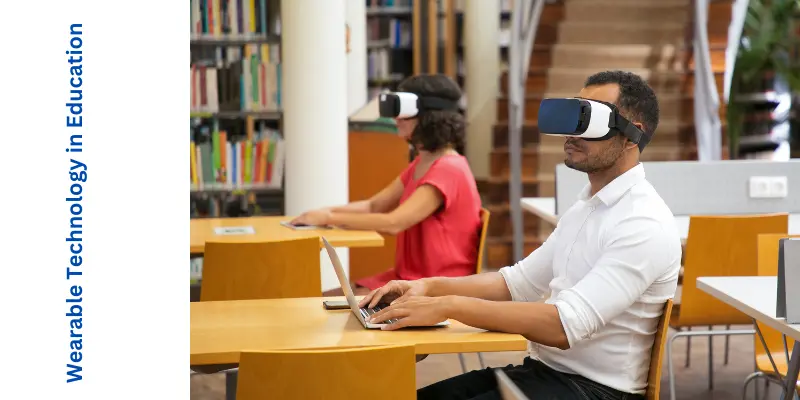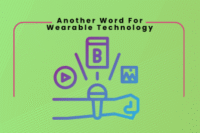Wearable Technology in Education: Enhancing Student Learning
Published: 09 Sep 2025
Wearable technology is transforming education. Studies show that smart devices like VR headsets, smartwatches, and AR glasses enhance learning by making lessons interactive. Schools worldwide are integrating these tools to improve student engagement and accessibility. But how exactly does wearable technology in education benefit students and teachers? Let’s explore.

How Wearable Technology is Used in Education
Wearable technology is transforming education by making learning more interactive and engaging. Let’s explore its key applications:
Enhancing Classroom Learning
Wearable technology is making classroom learning more interactive and fun. Here’s how:
Smart Glasses:
Smart glasses let you see digital information right in front of your eyes, making daily tasks easier and more interactive.
- Help students see complex topics in 3D.
- Example: Visualizing the human body or a chemistry experiment.
VR Headsets:
VR headsets take you into a virtual world, giving you an immersive experience for gaming, training, and entertainment.
- Create immersive experiences for deeper understanding.
- Example: Taking a virtual trip to ancient Rome or exploring space.
Smartwatches:
Smartwatches keep you connected on the go, helping you track health, fitness, and daily activities right from your wrist.
- Assist with time management and organization.
- Example: Reminding students about homework or class schedules.
These tools make learning more effective, engaging, and enjoyable for everyone!
Improving Student Engagement
Student engagement means keeping learners active, focused, and motivated in class. It makes learning more fun and helps students understand better.
- Gamification using wearable devices for interactive learning.
- Fitness trackers to enhance physical education activities.
- Language learning tools with real-time translation for better comprehension.
- Smart rings for quick access to digital resources.
- Brainwave-sensing headbands to improve focus and concentration.
Wearable Technology for Students with Disabilities
Wearable technology is a big help for students with disabilities. It makes learning easier and more fun for everyone.
- For Hearing-Impaired Students:
- Wearables like speech-to-text devices turn spoken words into written text.
- This helps students follow along in class without missing anything.
- For Visually Impaired Learners:
- Haptic feedback tools, like smart belts or watches, use vibrations to guide students.
- Example: Helping a student find their way around the classroom or feel shapes in a math lesson.
These devices are like special helpers. They make sure every student gets the support they need to learn and grow.
Remote Learning and Virtual Collaboration
Wearable technology makes remote learning exciting and easy. It helps students learn from anywhere and work together in fun ways.
VR and AR for Virtual Field Trips:
VR and AR let students explore places like museums, space, or historical sites without leaving the classroom, making learning exciting and interactive.
- Imagine visiting the pyramids of Egypt or the bottom of the ocean—all from your classroom!
- VR and AR headsets let students go on virtual field trips without leaving their seats.
Smart Rings and Voice Assistants for Hands-Free Learning:
Smart rings and voice assistants let students access information, take notes, or set reminders without using their hands, making learning easier and more convenient.
- Smart rings and voice assistants help students learn without using their hands.
- Example: You can ask a question or take notes just by speaking.
Wearables for Real-Time Collaboration:
Wearables help students and teachers share ideas instantly, making teamwork smoother and learning more connected.
- Wearable devices let students work together in real-time, even if they’re far apart.
- Example: Smart glasses can show what a teammate is seeing, making group projects easier.
Benefits of Wearable Technology in Education
Wearable technology in schools brings many benefits to students and teachers. Here’s how it helps:
Makes Learning Fun and Interactive:
Wearable technology turns lessons into engaging experiences, helping students learn by doing instead of just reading or listening.
- Wearables like AR glasses turn boring lessons into exciting adventures.
- Example: Imagine exploring the solar system or walking with dinosaurs—all in your classroom!
Helps Students Stay Organized:
Wearables remind students about classes, assignments, and schedules, making it easier to stay on track and manage time well.
- Smartwatches remind students about homework, tests, and class schedules.
- No more forgetting important tasks!
Supports Different Learning Styles:
Wearables adapt to visual, auditory, and hands-on learners, giving each student a way to learn that fits them best.
- Some students learn by seeing, others by doing.
- Wearables like VR headsets help everyone learn in a way that works best for them.
Encourages Health and Wellness:
Wearables track steps, sleep, and activity, helping students stay healthy and balanced while they focus on learning.
- Fitness trackers remind students to move and stay active.
- They also track sleep, helping students stay healthy and focused.
Makes Learning Personal:
Wearables adjust lessons to each student’s needs, giving them a learning experience that feels unique and tailored.
- Wearables can track progress and suggest lessons tailored to each student’s needs.
- This makes learning faster and more effective.
Wearable technology is like a super tool for education. It makes learning easier, healthier, and more fun for everyone!
Wearable Devices in Education
Wearable devices are becoming popular tools in schools. They help students and teachers in many ways. Here’s how:
Smartwatches:
Smartwatches give quick access to messages, health tracking, and reminders, making daily life simpler and more connected.
- Remind students about homework, tests, and class schedules.
- Track steps and encourage physical activity.
“Smartwatches are one of the most popular wearable devices today. To dive deeper, check out our article on Wearable Technology Shoes: The Future of Smart Footwear.”
Fitness Trackers:
Fitness trackers monitor steps, heart rate, and activity levels, helping users stay active and reach their health goals.
- Monitor heart rate, steps, and sleep.
- Help students stay healthy and active during gym classes.
Fitness trackers help people stay active and healthy. The Mayo Clinichttps://www.mayoclinic.org/?utm_source=chatgpt.com shares insights on how activity trackers encourage healthier lifestyles.
AR/VR Headsets:
AR/VR headsets create immersive experiences, letting users explore virtual worlds or add digital elements to real life.
- Make lessons exciting and interactive.
- Example: Virtual field trips to historical places or 3D exploration of the human body.
Smart Glasses:
Smart glasses display useful information in front of your eyes, making tasks easier and hands-free.
- Show digital information in the real world.
- Example: Display translations or science diagrams during lessons.
Haptic Devices:
Haptic devices use touch and vibration to give feedback, making digital experiences feel more real and interactive.
- Use vibrations to help visually impaired students.
- Example: A smart belt can guide them around the classroom.
Wearable devices are like super helpers in education. They make learning fun, interactive, and accessible for everyone!
Challenges of Wearable Technology in Education
While wearable technology is amazing, it also has some challenges. Let’s take a look at the main ones:
- High Costs and Accessibility Issues:
Wearable devices can be expensive. Not all schools or families can afford them, which makes it hard for everyone to use these tools. - Privacy and Data Security Concerns:
Wearables collect a lot of information, like student activity and health data. Keeping this data safe and private is a big challenge. - Dependence on Internet Connectivity:
Many wearables need the internet to work. If the internet is slow or unavailable, these devices might not function properly.
Even with these challenges, wearable technology is still a powerful tool for education. We just need to find ways to solve these problems!
Future of Wearable Technology in Education
The future of wearable technology in schools is super exciting! Here’s what’s coming next:
- AI-Powered Smart Wearables:
Imagine a smartwatch that knows when you’re stuck on a math problem and gives you hints. AI-powered wearables will act like personal tutors, helping students learn at their own pace. - Integration with Personalized Learning:
Wearables will make learning more personal. For example, they can track how you learn best and suggest lessons that match your style. - Expansion of AR/VR in Classrooms:
AR and VR will become even more common. Students might use AR glasses to see 3D models of the human body or VR headsets to visit ancient civilizations.
The future of wearable tech in education is bright. It will make learning more fun, personal, and interactive for everyone!
Let’s embrace this exciting change! Explore how wearable technology can make learning better for you or your students. The future of education is here—don’t miss out!
FAQs:
Wearable technology in education uses smart devices like AR glasses, fitness trackers, and VR headsets to enhance learning. These devices provide interactive lessons, track student health, and offer real-time language translation. They help create an engaging and personalized learning experience for students.
Wearables help by using speech-to-text for hearing-impaired students and haptic feedback tools for visually impaired learners, making lessons more accessible.
Wearables increase engagement through gamified learning, fitness tracking, real-time translation, and tools that improve focus and concentration.
The future includes AI-powered smart wearables acting as personal tutors, more personalized learning experiences, and wider use of AR/VR in classrooms.
Conclusion
Wearable technology is changing the way we learn. From smartwatches to AR glasses, these devices make education more fun, interactive, and personal. While there are challenges like cost and privacy, the benefits are huge. The future of wearable tech in schools is bright, with AI, personalized learning, and AR/VR leading the way.

- Be Respectful
- Stay Relevant
- Stay Positive
- True Feedback
- Encourage Discussion
- Avoid Spamming
- No Fake News
- Don't Copy-Paste
- No Personal Attacks

- Be Respectful
- Stay Relevant
- Stay Positive
- True Feedback
- Encourage Discussion
- Avoid Spamming
- No Fake News
- Don't Copy-Paste
- No Personal Attacks



